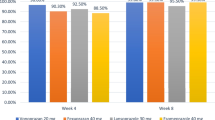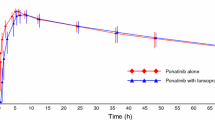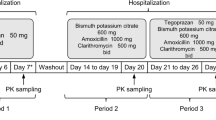Abstract
Objective
Esomeprazole is the first proton pump inhibitor to be developed as an optical isomer for the treatment of patients with acid-related diseases. The aim of this study was to examine the pharmacokinetics and tolerability of esomeprazole in the elderly, relative to middle-aged patients with gastro-oesopha-geal reflux disease (GORD).
Design
Nonblinded single-centre pharmacokinetic study with historical control group.
Patients and Participants
14 healthy elderly volunteers [mean age 74 (range 71 to 80) years].
Methods
Participants received treatment with esomeprazole 40mg once daily for 5 days, with 24-hour blood sampling on days 1 and 5. The total area under the plasma concentration-time curve (AUC∞), maximum plasma drug concentration (Cmax), terminal elimination half-life (t1/2z) and time to Cmax (tmax) were determined for the parent drug and its hydroxy and sulphone metabolites. AUC∞ and Cmax data were compared with those in an historical group of 36 middle-aged patients [mean age 45 (range 29 to 58) years] with GORD, treated with an identical dosage of esomeprazole for 5 days.
Results
A total of 13 volunteers completed the study. On day 5, the mean plasma AUC∞ of esomeprazole was 16.0 µmol · h/L, Cmaxwas 5.6 µmol/L, tmax was 1.5 hours and t1/2z was 1.7 hours. The AUC∞ and Cmax values for the parent drug were 2- and 1.5-fold higher on day 5 compared with day 1. AUC∞ and Cmax values for the sulphone metabolite increased to a slightly greater extent, and values for the hydroxy metabolite were unchanged. Ratios of the AUC∞ and Cmax values between elderly volunteers and patients with GORD were 1.25 [95% confidence interval (CI) 0.94, 1.67] and 1.18 (0.91, 1.52), respectively. Esomeprazole was well tolerated and there were no safety concerns.
Conclusions
The AUC∞ and Cmax values in the elderly were not significantly different from those obtained in a group of middle-aged patients. The difference for AUC∞ was 25% (95% CI −6% to +67%). Esomeprazole has a wide therapeutic window and our results do not indicate that dosage adjustment should be necessary in the elderly.




Similar content being viewed by others
References
Richardson P, Hawkey CJ, Stack WA. Proton pump inhibitors: pharmacology and rationale for use in gastrointestinal disorders. Drugs 1998; 56: 307–35
Sotaniemi EA, Arranto AJ, Pelkonen O, et al. Age and cytochrome P450-linked drug metabolism in humans: an analysis of 226 subjects with equal histopathologic conditions. Clin Pharmacol Ther 1997; 61: 331–9
Andersson T. Pharmacokinetics, metabolism and interactions of acid pump inhibitors. Focus on omeprazole, lansoprazole and pantoprazole. Clin Pharmacokinet 1996; 31: 9–28
Breuel HP, Hartmann M, Bondy S, et al. Pantoprazole in the elderly: no dose-adjustment [abstract]. Gut 1994; Suppl. 4: 77
Flouvat B, Delhotal-Landes B, Cournot A, et al. Single and multiple dose pharmacokinetics of lansoprazole in elderly subjects. Br J Clin Pharmacol 1993; 36: 467–9
Landahl S, Andersson T, Larsson ME, et al. Pharmacokinetic study of omeprazole in elderly healthy volunteers. Clin Pharmacokinet 1992; 23: 469–76
Lind T, Rydberg L, Kylebäck A, et al. Esomeprazole provides improved acid control versus omeprazole in patients with symptoms of gastro-esophageal reflux disease. Aliment Pharmacol Ther 2000; 14: 861–7
Äbelö A, Andersson TB, Antonsson M, et al. Stereoselective metabolism of omeprazole by human cytochrome P450 enzymes. Drug Metab Dispos 2000; 28: 966–72
Lagerström PO, Persson BA. Determination of omeprazole and metabolites in plasma and urine by liquid chromatography. J Chromatography 1984; 309: 347–56
Hussein Z, Granneman GR, Mukherji D, et al. Age-related differences in the pharmacokinetics and pharmacodynamics of lansoprazole. Br J Clin Pharmacol 1993; 36: 391–8
Laurent AL, Merritt GJ, Setoyama T, et al. Rabeprazole: pharmacokinetics and safety in the elderly. Clin Geriatr 1999; 7: 27–33
Delhotal-Landes B, Petite JP, Flouvat B. Clinical pharmacokinetics of lansoprazole. Clin Pharmacokinet 1995; 28: 458–70
Barclay ML, Begg EJ, Robson RA, et al. Lansoprazole pharmacokinetics differ in patients with esophagitis compared to healthy volunteers. Aliment Pharmacol Ther 1999; 13: 1215–9
Ching MS, Mihaly GW, Angus PW, et al. Oral bioavailability of omeprazole before and after chronic therapy in patients with duodenal ulcer. Br J Clin Pharmacol 1991; 31: 166–70
Hassan-Alin M, Andersson T, Bredberg E, et al. Pharmacokinetics of esomeprazole after oral and intravenous administration of single and repeated doses to healthy subjects. Eur J Clin Pharmacol 2000; 56: 665–70
Abernethy DR, Greenblatt DJ. Impairment of lidocaine clearance in elderly male subjects. J Cardiovasc Pharmacol 1983; 5: 1093–6
Nation RL, Triggs EJ, Selig M. Lignocaine kinetics in cardiac patients and aged subjects. Br J Clin Pharmacol 1977; 4: 439–48
Andersson T, Miners JO, Veronese ME, et al. Identification of human liver cytochrome P450 isoforms mediating omeprazole metabolism. Br J Clin Pharmacol 1993; 36: 521–30
Andersson T, Miners JO, Veronese ME, et al. Identification of human liver cytochrome P450 isoforms mediating secondary omeprazole metabolism. Br J Clin Pharmacol 1994; 37: 597–604
Author information
Authors and Affiliations
Corresponding author
Rights and permissions
About this article
Cite this article
Hasselgren, G., Hassan-Alin, M., Andersson, T. et al. Pharmacokinetic Study of Esomeprazole in the Elderly. Clin Pharmacokinet 40, 145–150 (2001). https://doi.org/10.2165/00003088-200140020-00006
Published:
Issue Date:
DOI: https://doi.org/10.2165/00003088-200140020-00006




